In the 2014 elections, when Hema Malini was contesting from Mathura, she was up against two other Hema Malinis.
In 2019, Shravan Kumar of Congress was up against another Shravan Kumar in Jhunjhunu in Rajasthan.
The politics of namesakes are continuing in the ongoing elections as well in the Gidderbaha constituency in Punjab where SAD candidate Hardeep Singh Dimpy Dhillon, is contesting against another Hardeep Singh, an independent candidate.
In the same constituency, two candidates from Punjab Lok Congress and Punjab Kisan Dal, both Om Prakash are fighting the polls.
AAP candidate Pritpal Sharma was spared the trouble after his namesake, an independent candidate withdrew his nomination.
There have been numerous such cases in the history of Indian elections where political parties have put up candidates with similar names to confuse voters. The only thing that comes to the rescue of voters amidst this confusion are the political party symbols.
Standing in the voting booth, the party symbol would ensure that the voter chooses the candidate of their choice even if their names wouldn't.
The significance of a party symbol is more than just a stamp-like drawing that appears on political posters and banners. It is the identification mark of a party that triggers, in the memory of the public, all things bad and good about a political outfit -- the party leaders’ speeches and their unfulfilled promises. Which is why it is no surprise that symbols feature in campaign slogans as often as the names of political leaders do.
A COMMUNICATION TOOL
“Chup Chap Kamal Chhaap'' was the campaign call of the Bharatiya Janata Party in the 2021 Bengal polls. In 2004, when the Congress was seeking to counter BJP's 'India Shining' narrative, its go to slogan was “Congress ka haath, aam aadmi ke saath”.
“When you have a large number of people who are not going to invest time and energy in understanding the party’s politics or engaging in politics in general, then it's just this pictorial image which, if it is drilled in through advertisements and pamphlets, stays with people when they go to vote," says Moushumi Bas, associate professor at the Jawaharlal Nehru University.
"It is this image that they associate with. It is a signifier".

The importance of a party symbol as a tool of communication can perhaps be best painted through the example of the Congress party that experimented with several symbols before settling with the hand or ‘panja’.
Following the Emergency, Congress saw a split in the party, with one faction being led by the former party president Brahmanada Reddy and the other by Indira Gandhi. The split also cost Gandhi the party symbol — a cow and a calf.
“Indira was reportedly relieved to let go of the cow and the calf, as it had been ridiculed throughout the country — the cow was seen as Indira and the calf as Sanjay,” writes Rasheed Kidwai in “Ballot: Ten Episodes that Have Shaped India’s Democracy”.
Gandhi is said to have requested the original Congress party symbol of a pair of bullocks carrying a yoke, which had been frozen by the Election Commission.
She was in turn given a choice between three symbols — a bicycle, an elephant and the open palm or the hand.
On the advice of All India Congress Committee general secretary Buta Singh, Gandhi picked the “Haath” which has now become a symbol that is said to stand for “truth, non-violence and unity.”
The use of party symbols is also an "inclusive" approach towards making the voting process "illiterate friendly", writes former Chief Election Commissioner SY Quraishi in his book “An Undocumented Wonder: The Great Indian Election”.
ALLOTMENT OF SYMBOLS
Political parties are allotted the symbols by the Election Commission of India under the Election Symbols (Reservation & Allotment) Order, 1968.
The ECI has a bank of symbols, often inspired from objects from the quotidian life that the public can easily identify with.
In the business of politics, the symbol is to a party what a logo is to a brand.
“It needs to be unique so that the moment somebody sees it they can just identify it with the party. The identification becomes very important,” Basu says.
It can be a broom, a hat, a fruit, a cycle, a lantern, or even an air conditioner.
These objects were transformed into minimalistic sketches in pencil by MS Sethi who was the in-house designer at the ECI until 1992 when he retired.
Quraishi notes that Sethi would sit with a team of officials at the nodal body to brainstorm over “daily objects that the common man could identify with” and draw them with his HB pencils.
Many established symbols of political parties — bicycle (Samajwadi Party), elephant (Bahujan Samaj Party), broom (Aam Aadmi Party) — were reportedly born of these sessions.
Among the recommended symbols were also “not so familiar” objects like a pair of glasses, a nail cutter, and a necktie.
Many of Sethi’s sketches continue to be part of the ECI’s collection of free symbols even today — a list of which is shared during every election.
As of September 23, 2021, there are 197 free election symbols including some immediately recognisable objects like an apple, a cricket bat, a belt and a bench.
The list also has objects that one wouldn’t immediately identify without reading the name written adjacent to it.
The symbol for biscuit can easily be mistaken for a zebra crossing with its alternating black and white strips had it not been for the word ‘biscuit’ written across the body of the sketch. The symbol for a coconut farm is a bunch of four coconut trees, and the symbol for a palanquin or “dolli” is almost unrecognisable in its wheel-less trailer-like sketch.
There are also symbols featuring human beings like a football player drawn as a man ready to kick the ball, a cricket batsman in his batting stance, and ‘nagrik’ or the citizen which is essentially a drawing of three people — a man and two women.
Interestingly, the man wears the western outfit of a shirt with a pair of trousers but the women wear ethnic outfits: a saree, and a salwar-kurta.
The list no longer, however, features any animals.
The most popularly known symbol of a live animal is that of the BSP — the elephant that was created during Sethi’s tenure.
“Living animals symbols are not allowed anymore (since 1990), because the animals can be abused. People would present those animals in their public meetings,” Quraishi said.
In a reportedly unfortunate incident, a candidate whose symbol was chicken had brought the bird to a polling booth where it was attacked by eagles.
The candidate, not surprisingly, lost.
To prevent such incidents, and because elections in India are an aggressive affair where parties have had the reputation of going to extreme lengths to win, in 2019, the ECI banned the use of animals in poll campaigns.
Sethi was the last draughtsman at the ECI, after which the post was abolished.

Quraishi says that parties can now choose from the available symbols or recommend symbols of their own as well.
On the current list of free symbols, there are some that have restricted availability.
Like the “Basket containing Fruits” is available in all states and union territories except in the state of Tamil Nadu; the cot is available everywhere except in Kerala; and the door handle can be chosen anywhere but Uttar Pradesh and Uttarakhand.
“That is because that symbol is already allotted to some party in that state,” Quraishi explained.
So for instance, if a symbol is taken by a party in Assam, another party in Uttar Pradesh can apply for it. The symbol, however, will not be up for grabs in Assam.
That is, however, not true for national parties, whose symbols will not be available anywhere in the country.
A party symbol of a regional party also ceases to be available when a party graduates to the status of a national party, as is now the case with the All Indian Trinamool Congress spearheaded by Mamata Banerjee.
According to the ECI, if a party is treated as a recognised political party in four or more states, it shall be known as a `National Party’ throughout the whole of India, but only so long as that political party continues to fulfil thereafter the conditions for recognition in four or more states on the results of any subsequent general election either to the House of the People or to the Legislative Assembly of any State.
There are currently seven national parties in the country — Bharatiya Janata Party, Communist Party of India, Communist Party of India (Marxist), Indian National Congress, National Congress Party, Bahujan Samaj Party and the All India Trinamool Congress.
WHO CAN APPLY
Before 2009, for a political party to be eligible for an election symbol, it had to prove itself a “serious party” by contesting at least two elections.
Only recognised national and state-level parties were entitled to a symbol.
However, in 2009, following a Supreme Court ruling directing the ECI to allot a symbol to actor-turned-politician Chiranjeevi’s Praja Rajyam Party, a registered but unrecognised political party, the criterion was amended in 2011.
“ECI can now give symbols to a new party, provided that they are big enough and can put up candidates in 10 per cent of the constituencies,” says Quraishi.
In the case of two or more parties vying for the same symbol, the ECI breaks the tie on a first come first serve basis, but there have been exceptions.
The broom which is now synonymous with Arvind Kejriwal’s Aam Aadmi Party was reportedly originally allotted to the Uttar Pradesh Naitik Party (UPNP) in 2012, but after the party lost in all its constituencies, the symbol was given to AAP because it displayed a substantial voter base.


























